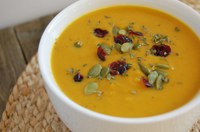Prairie Fare: How Much Do You Use the Internet?
(Click an image below to view a high-resolution image that can be downloaded)
By Julie Garden-Robinson, Food and Nutrition Specialist
NDSU Extension
“Mom, this is just like those scary movies,” my older daughter teased. “First, they cut your phone lines so you can’t call for help.”
I had just discovered that our landline phone didn’t work. I knew our wireless internet connection was down.
“We have cellphones with data,” I reminded her, although she caused me to pause in my tracks.
“Go read a book,” my husband said, unsympathetically.
“But I have an online test to take,” she said.
“I need to check my homework assignments online,” our younger daughter said.
“Well, I need to order an airline ticket and do some other business,” I said.
I wanted to check in on Facebook, too, but I didn’t mention that. I knew our daughters wanted to check in with their friends on Snap Chat, and I am sure my husband wanted to check sports scores.
We called the company and learned that the outage probably would last awhile. Would we last?
Before the end of the day, I received a text that we had used all of our cellphone data and we had incurred an overage fee. That has happened only a couple of times in the many years we’ve had cellphones.
Suffice it to say, all the Robinsons became a bit irritable while I put us on an “internet diet” and had them seek out free Wi-Fi.
Were we addicted to the internet? When our connection was restored, I looked into the psychology of “Internet Addiction Disorder.”
People with the disorder may experience agitation, mood swings, fear, depression and social isolation, among many symptoms. They may have physical symptoms including headaches, back aches, insomnia and/or weight gain due to poor nutrition.
We were just frustrated. We all breathed a sigh of relief when our internet connection was restored and everyone could do homework, read and interact online.
According to the PEW Research Center’s January 2018 survey, 77 percent of U.S. adults go online daily, including 26 percent who are online “almost constantly.” About 11 percent of U.S. adults do not use the internet at all.
We all know that we can’t believe everything we read or hear, and, of course, that holds true with online information. Some information can be downright dangerous to your health.
Harness the power of the internet as a helpful tool, but ponder these questions as you explore online food, nutrition and health information:
- Who is the author?
- What are the author’s credentials?
- Is a credible sponsoring institution identified?
- What is the purpose of the information?
- Is the site promoting or selling a particular product? (Commercial websites often end in “.com.”)
- Is the information based on scientific research or opinion? (Government websites ending in “.gov” offer free information without commercial bias.)
- How current is the information? Is a date listed?
- Are the facts documented with sound scientific references? Or is the information solely based on personal testimonials?
- Is the information well-written in terms of grammar and spelling? What is the tone of the writing? Does it take a balanced approach?
Here’s a tasty and nutritious recipe with lots of fiber, vitamin A and other vitamins to nourish your body. See https://www.ag.ndsu.edu/nourishyourbody for more information and links to credible information about staying healthy.
Savory Pumpkin Soup
1 Tbsp. olive oil
1 medium red onion, chopped
3 garlic cloves, minced
2 Tbsp. chopped sage (about 10 leaves)
4 c. low-sodium vegetable broth
1 (15-ounce) can pumpkin puree (not pumpkin pie filling)
1 (15 1/2-ounce) can navy beans
1 tsp. turmeric
1/2 tsp. nutmeg
1/2 tsp. salt
1/8 tsp. pepper
Dried cranberries, pomegranate seeds and/or sage for garnish (optional)
In a large pot, heat olive oil over medium heat. Add onion and cook for five to seven minutes, until translucent. Add garlic and sage, and cook for another minute. Add vegetable broth, pumpkin, beans, turmeric, nutmeg, salt and pepper, and stir to combine. Bring to a simmer. Allow the soup to cool before transferring in small portions to a blender to puree. You may use an immersion blender, too. Transfer the soup back into the pot and let cook on medium-low heat for five to 10 minutes. Add additional salt and pepper to taste. Garnish as desired.
Note: Adding additional beans and pumpkin will change the consistency. If a thicker consistency is desired, add more beans and pumpkin.
Makes six 1-cup servings. Each serving has 130 calories, 2.5 grams (g) fat, 5 g protein, 21 g carbohydrate, 6 g fiber and 300 milligrams sodium.
(Julie Garden-Robinson, Ph.D., R.D., L.R.D., is a North Dakota State University Extension food and nutrition specialist and professor in the Department of Health, Nutrition and Exercise Sciences. Follow her on Twitter @jgardenrobinson)
NDSU Agriculture Communication - Oct. 11, 2918
| Source: | Julie Garden-Robinson, 701-231-7187, julie.garden-robinson@ndsu.edu |
|---|---|
| Editor: | Ellen Crawford, 701-231-5391, ellen.crawford@ndsu.edu |



